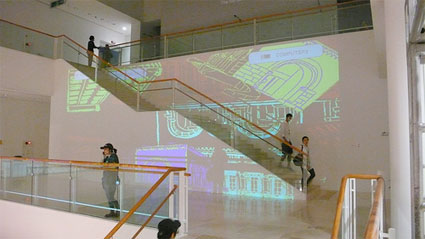
Finally some time to put order in my brain and write a few lines about the 5th edition of Seoul International Media Art Biennale, aka media_city Seoul.
With some 70 artists showing their work, the biennial is a very satisfying but also very overwhelming experience, especially because the event features so many pieces that require time and reflection, and so many artists whose work i had never heard of. Thank god and the curators, there were very few of those installations that look more like entertaining gizmos than art. Most of the time they require the audience to wave their hands or move around so that whatever is projected on a screen will move. Or will perform some magical trick like spitting out smoke. Apparently some visitors have seen this kind of work too much: i saw a few people flapping their arms in a desperate attempt to ‘interact’ with a piece which was perfectly happy to function without human help, thank you.
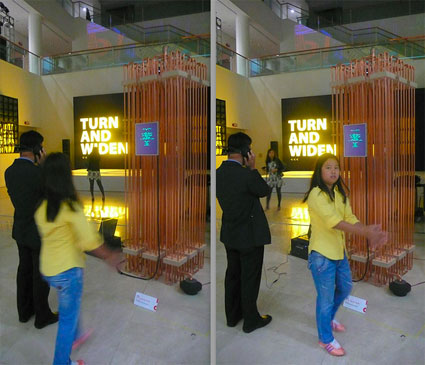 Sorry Miss, this installation is good but it won’t interact: Hello World by Yunchul Kim
Sorry Miss, this installation is good but it won’t interact: Hello World by Yunchul Kim
I saw some great pieces of media art in Seoul and they put the emphasis on ‘art’ rather than ‘media’. media_city Seoul is the only major biennial i’ve heard of that is entirely dedicated to media art. It doesn’t take place in a gallery or in one of those ueber-trendy disused industrial spaces outside the city. It is located in a very official, big, and bright art institutions: the Seoul Museum of Art.
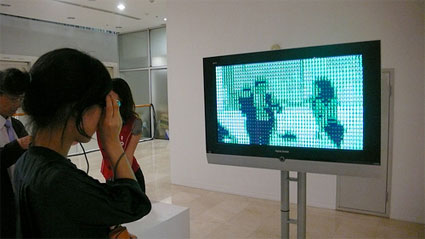 Visitors trying on Electroboutique‘s virtual reality goggles
Visitors trying on Electroboutique‘s virtual reality goggles
The thing that puzzles me is the existence of a media art biennial. Not because i am per se unconvinced by the idea of applying the structure and vocabulary of ‘traditional’ contemporary art onto media art. Not because of all the discussions about the overflow of biennials all over the world and the obsolescence of their concept. I love biennials, any celebration of art is good for me. No, what perplexes me is that, once again, media art is treated like the odd kid who has to be separated from the others. If on the one hand it’s fantastic that a city has the guts to dedicate two month to media art and host the event in a museum, i wonder how long it will take until media art is regarded as ‘art’ and integrated into other contemporary art events without anyone finding it extraordinary, brave or strange. We’re getting there i know but, damn! it’s slow. Anyway, not sure this French expression translates well in english but i’m going to stop ‘spitting in the soup’ and just rejoice in this opportunity i had to see so many great works.
Starting with 2 examples taken from Marie Sester‘s Exposure series, an artwork which started as videos that explores how X-ray imagery was used for surveillance, before 9/11.
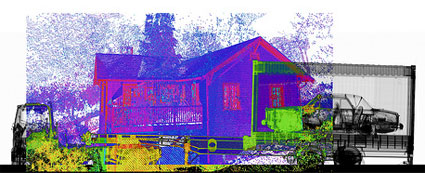 Exposure, Marie Sester
Exposure, Marie Sester
One photo shows an X-rayed truck containing what are very probably smuggled items. In another one, an X-rayed horse trailer is elegantly juxtaposed with a house, which eventually overtakes the entire screen. The horse trailer has a luxury car hidden inside. The house was scanned by laser as well. Today, Exposure is a work stronger than ever. Marie Sester has also noted that today, as an artist, she would never have access to images like the ones included in “Exposure” due to the levels of control that entities, which she approached in the past, have placed on their surveillance technologies.
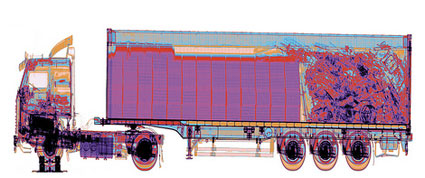 Exposure, Marie Sester
Exposure, Marie Sester
When walking in the museum lobby, you might be startled by the sound of an aircraft flying overhead. Up there above you, the gigantic shadow of an aircraft is passing quietly and menacingly over the ceiling. The only on-going attack I-Chen Kuo’s work Invade the SeMA (SeMA being of course the Seoul Museum of Art) refers to is the one that sees artists invading art institutions, with or without their consent.
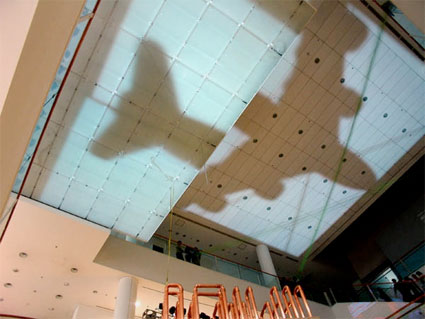 Invade the SeMA by Kuo I-Chen
Invade the SeMA by Kuo I-Chen
One of the best art pieces i saw at the biennial is Life Writer by Christa Sommerer and Laurent Mignonneau. An old type writer rescued from the era of analogue text processing and normal piece of paper become the vivarium for a swarm of artificial life creatures. The letters that you type appear as projected characters on the paper. When you push the carriage return, the letters turn into small black creatures that creep or fly over the paper. The creatures are based on genetic algorithms where text is used as the genetic code that determines the shape, behaviour and movements of the creatures.
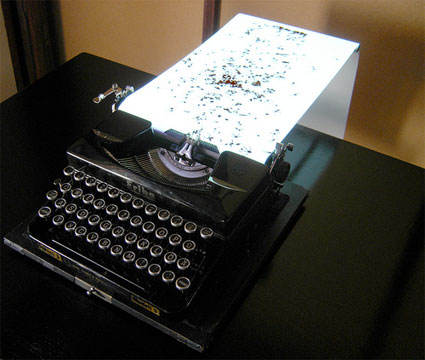 Life Writer Machine, Christa Sommerer and Laurent Mignonneau
Life Writer Machine, Christa Sommerer and Laurent Mignonneau
The creatures need to eat text to stay alive and when they will try to snap up the new characters you type. Once they have eaten enough text they can also reproduce and have off-spring.
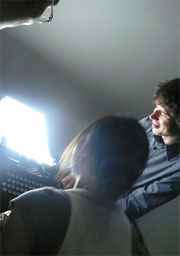 By connecting the act of typing to the act of creation of life, Life Writer deals with the idea of creating an open-ended artwork where user-creature and creature-creature interaction become essential to the creation of digital life and where an emergent systems of life-like art emerges on the boundaries between analog and digital worlds.
By connecting the act of typing to the act of creation of life, Life Writer deals with the idea of creating an open-ended artwork where user-creature and creature-creature interaction become essential to the creation of digital life and where an emergent systems of life-like art emerges on the boundaries between analog and digital worlds.
The interesting part was to hear and see how the young people behave in front of the typewriter. They never had to use it so they tend to type using very soft and light gestures as if the keyboard of machine was as sensible as a the one of a cell phone.
For his project Adam Smith: a million of good reasons to become millionaire, Damián Ontiveros Ramírez asked students of economy and accounting to help him draw the figure of Adam Smith, an 18th century Scottish philosopher and a pioneer of political economy. One of the key figures of the Scottish Enlightenment, Smith is the author of An Inquiry into the Nature and Causes of the Wealth of Nations, an essay regarded as the first modern work of economics.
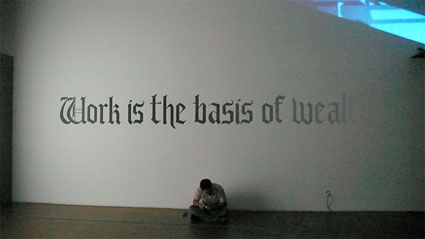 A view from Damián Ontiveros Ramírez’ installation
A view from Damián Ontiveros Ramírez’ installation
The artist’s objective is to total 1,000,000 drawings that show Adam Smith performing different actions. Each of them suggests a way to make money, as the Scottish economist had claimed that the source of wealth is labor. For media_city Seoul, the artist is showing digital animations of some of the drawings.
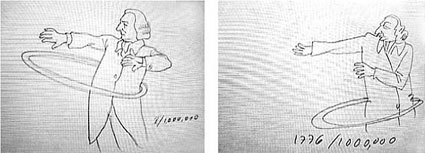 Damián Ontiveros Ramírez, Adam Smith: A Million of Good Reasons to Become Millionaire
Damián Ontiveros Ramírez, Adam Smith: A Million of Good Reasons to Become Millionaire
Herwig Turk is showing two works which question the standards of perception. The first part of the installation, Uncertainty, takes its cue from Austrian physicist Dr. Manfred Drosg who stated that ” A model can never be a perfect portrayal of reality, and there can never be a part of reality perfectly mirrored by a model”.
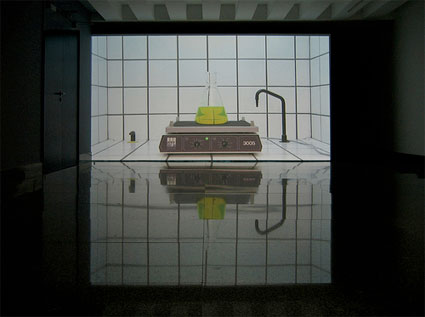 Herwig Turk, uncertainty
Herwig Turk, uncertainty
In this two-channel video installation, which Turk developed in collaboration with Paulo Pereira, a camera registers the movement of a fluorescent solution set on top of a shaker. The camera is supported by a similar shaker, set to move at the same speed, in an attempt to reproduce the solution’s exact motion. In a precisely controlled experiment the solution would not move. This, however, is impossible since the movement of both shakers can never be perfectly synchronized. This impossibility is represented on one of the screens, whereas on the second screen the movement has been artificially synchronized through post-production, so that the solution no longer moves. However, on this screen the whole stage begins to move. The artificial immobilization of the fluorescent solution results in an apparent shaking of the white background, making the stillness of the vibrating solution distressing. A small black border occasionally appears on the screen’s periphery, dissolving yet another reference: the frame of the screen.
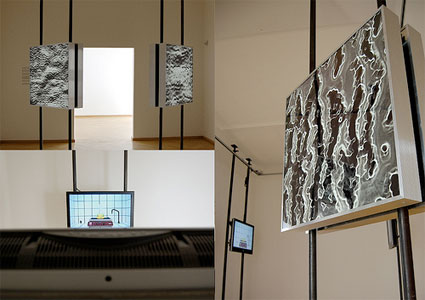 Herwig Turk, DNA film
Herwig Turk, DNA film
The second part of the installation, DNA film, consists of an animation of DNA separated in an agarose gel. The pulsating black and white structures are an artistic translation of DNA-sequences, which are interpreted as the twilight zone between being and nothingness. By measuring the average luminance within the single frames, a structure was found to generate the sound that is directly referring to the picture. The artwork refers to the constant need for translation within science and art and just like uncertainty, it focuses on the manipulation of scientific image.
To be continued…
media_city Seoul runs until November 5, 2008 at the Seoul Museum of Art.
